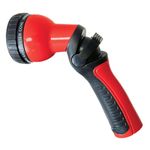
Today we’re off to New York City with Virginia Sherry, a plant lover and founder of the nonprofit Native Plant Society of Staten Island.
Good morning! The native and nonnative plants in my garden are starting to bloom, and the bees are visiting. Here are some highlights.
 Oeothera is a large genus. Some species, like this native (sundrops, Oenothera fruticosa, Zones 4–8), have flowers that open during the day and go by the common name of sundrops, while others open up in the evening and are called evening primroses.
Oeothera is a large genus. Some species, like this native (sundrops, Oenothera fruticosa, Zones 4–8), have flowers that open during the day and go by the common name of sundrops, while others open up in the evening and are called evening primroses.
 Native to Europe, Bachelor’s button (Centaurea cyanus, annual) also goes by the common name of cornflower because it used to be a common weed in grain fields. Now it is grown on purpose for its beautiful flowers.
Native to Europe, Bachelor’s button (Centaurea cyanus, annual) also goes by the common name of cornflower because it used to be a common weed in grain fields. Now it is grown on purpose for its beautiful flowers.
 Mediterranean bells (Nectaroscordum siculum, Zones 4–8) has clusters of nodding flowers in early summer. A close relative of ornamental onions (and classified in the genus Allium by taxonomists), it has an oniony smell if you bruise the foliage, which makes it unappealing to deer, rabbits, and other pests.
Mediterranean bells (Nectaroscordum siculum, Zones 4–8) has clusters of nodding flowers in early summer. A close relative of ornamental onions (and classified in the genus Allium by taxonomists), it has an oniony smell if you bruise the foliage, which makes it unappealing to deer, rabbits, and other pests.
 Pink wood sorrel (Oxalis crassipes ‘Rosea’, Zones 6–10) is a little bulb that makes a nice clump of bright green leaves topped with bright pink flowers that can be produced all summer in the right conditions. In hot, dry summers it will go dormant and return in the fall or spring.
Pink wood sorrel (Oxalis crassipes ‘Rosea’, Zones 6–10) is a little bulb that makes a nice clump of bright green leaves topped with bright pink flowers that can be produced all summer in the right conditions. In hot, dry summers it will go dormant and return in the fall or spring.






Have a garden you’d like to share?
Have photos to share? We’d love to see your garden, a particular collection of plants you love, or a wonderful garden you had the chance to visit!
To submit, send 5-10 photos to gpod@taunton.com along with some information about the plants in the pictures and where you took the photos. We’d love to hear where you are located, how long you’ve been gardening, successes you are proud of, failures you learned from, hopes for the future, favorite plants, or funny stories from your garden.
If you want to send photos in separate emails to the GPOD email box that is just fine.
Have a mobile phone? Tag your photos on Facebook, Instagram or Twitter with #FineGardening!
You don’t have to be a professional garden photographer – check out our garden photography tips!
Do you receive the GPOD by email yet? Sign up here.
Fine Gardening Recommended Products

ARS Telescoping Long Reach Pruner
Fine Gardening receives a commission for items purchased through links on this site, including Amazon Associates and other affiliate advertising programs.

Planting in a Post-Wild World: Designing Plant Communities for Resilient Landscapes
Fine Gardening receives a commission for items purchased through links on this site, including Amazon Associates and other affiliate advertising programs.

Dramm Revolution Adjustable 9-Pattern Metal Hose Nozzle
Fine Gardening receives a commission for items purchased through links on this site, including Amazon Associates and other affiliate advertising programs.
- Ergonomic insulated grip
- Maximum pressure of 90 PSI
- Fully adjustable spray pattern
- No trigger lock


















Comments
All so very pretty!! Especially love that graceful columbine blossom.
Really great photography- I can see every detail- better than real life!
Interesting to think of NYC as having native plants...when I look at the photos I feel like I'm in the meadow.
I checked out the website too- very nice.
Beautiful set of flowers and photos.
Thank-you for sharing.
Log in or create an account to post a comment.
Sign up Log in